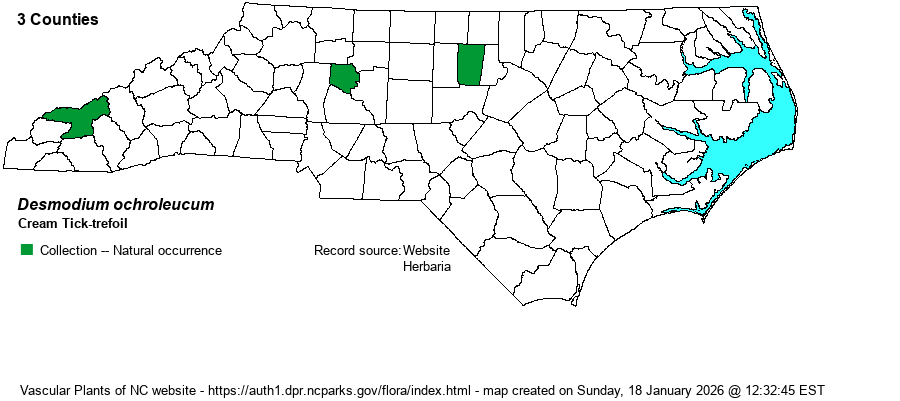| Author | M.A. Curtis ex Canby | |
| Distribution | Collected only three times, once each from three counties: Swain (Mountains) in 1891, and Davie in 1956 and Orange in 1960 in the Piedmont.
This is probably the rarest of the Desmodium species in the U.S., occurring only in a few dozen counties across its range -- DE and southeastern MO on the north, and the FL panhandle and MS on the south. Most records are from AL at the present time, as it has strongly decreased. | |
| Abundance | Of historical occurrence. It had always been very rare in the state, and a few older collections were incorrect, being D. rotundifolium instead. It is state-listed as Special Concern - Historical, and its Global Rank is G2G3. It probably should be Federally listed as Threatened, though there may be enough current populations in AL to prevent this from happening. Note that it has recently been re-discovered (2017 and later) in the Coastal Plain of VA, in three counties, according to the Digital Atlas of the Virginia Flora. Thus, it certainly could be re-discovered in NC, even possibly in the Coastal Plain. | |
| Habitat | This is a species of high pH soils, in mainly dry situations. Most frequent (elsewhere) in upland hardwood or mixed forests, but it also occurs in barrens. It favors shady or mostly shady conditions. The habitat of "swamp forest" for the Davie County collection is truly baffling and makes one pause that the species was incorrectly identified. Recent VA habitats are from "a fluvial terrace woodland" and "along roadsides"! |
| Phenology | Blooms from June to August, and fruits from August to October. | |
| Identification | This is an unusual Desmodium species, confusable only with the quite common D. rotundifolium in leaf. This species has a trailing stem, almost vine-like, that reaches 2-3 feet long, and it is quite pubescent. It may have a few branches, and the leaves have fairly long petioles, about 1.5 inches long. The three leaflets are somewhat ovate to diamond-shaped, with the terminal one being about 2 inches long and not quite as wide. The lateral leaflets are somewhat smaller, as in most other Desmodium species. Its most distinctive character is the flower color -- flowers are creamy to white in color, very much different from the pink to rose color of all others in the genus, and they are also quite large (about 1/3-inch across). The flowers are on somewhat erect racemes, terminal and from leaf axils, reaching 6-8 inches tall or long. As the flowers will only be present for a few weeks at best, the hairy trailing stem and the ovate leaflets are likely going to be the most useful characters for this extremely rare species. The pods are hairy/uncinate (hooked) only along the sutures, where it splits open, whereas in the similar D. rotundifolium the pods are uncinate (hooked) over the entire surface. This species has been actively surveyed for across the Piedmont in recent decades, without success. Thus, it is genuinely of historical occurrence, and discovery of a population in NC would be worthy of celebration. | |
| Taxonomic Comments | None
| |
| Other Common Name(s) | Creamflower Tick-trefoil, Creamy Tick-trefoil | |
| State Rank | SH | |
| Global Rank | G2G3 | |
| State Status | SC-H | |
| US Status | | |
| USACE-agcp | | |
| USACE-emp | | |

